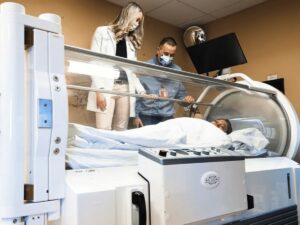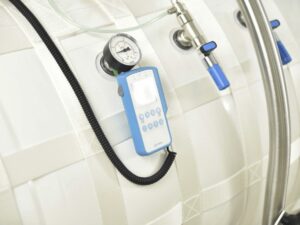Are your hyperbaric treatment offerings as safe as they could be? Ensuring the safety of hyperbaric chamber sessions is essential for businesses, impacting clients’ well-being and operational success.
With years of expertise in hyperbaric medicine, my insights come from a blend of technical knowledge and real-world application. This experience positions me to offer valuable advice to improve safety standards.
Safety in hyperbaric chambers requires a thorough understanding of every aspect. A well-implemented safety checklist is crucial for preventing incidents and securing the well-being of the patients and operators.
In this guide, you will learn about the essential safety measures to implement before, during, and after hyperbaric chamber sessions, giving you a comprehensive overview to elevate your practice.
Read for an exciting safety exploration!
1. Pre-Setup Safety Checklist for the Chamber
Ensuring the chamber’s readiness is the first step in safeguarding the hyperbaric treatment process. Here are essential checklists to consider:
Electrical System Safety
The electrical systems of a hyperbaric chamber must be in perfect working order to guarantee safety and functionality. For example, checking all electrical connections for signs of damage or corrosion and ensuring that emergency shutoff mechanisms are functional. Electrical safety is essential to prevent fires and certify that life-support systems continue to function during a power outage.
Chamber Integrity
Inspect the chamber for any signs of wear and tear, such as cracks or seal degradation. The structural integrity is crucial for creating and maintaining the correct pressure levels safely. Now, this is important, any compromise could pose significant risks to both patients and staff. Schedule regular maintenance checks to address these issues promptly.
Oxygen and Gas Supply Checks
Oxygen-ark’s hyperbaric chambers rely on a controlled supply of oxygen to create a therapeutic environment. This step involves checking the oxygen and any other gas supplies for purity and proper pressure levels. It’s also essential to check that there are no leaks in the gas supply lines and that backup gas supplies are available if needed, a practice I take very seriously.
Communication Systems
Effective communication between the patient inside the chamber and the operator outside is vital. The checklist should include testing all audio and visual communication devices for clarity and reliability. It’s also important to have a backup communication system in case the primary system fails. This guarantees that any concerns or emergencies can be promptly addressed.
Emergency Procedures and Equipment
Finally, having a clear set of emergency procedures and ensuring that all emergency equipment is in place and operational is critical. This includes checking the availability of fire extinguishers, emergency oxygen masks, and first-aid kits. The staff should be trained on emergency evacuation procedures and the use of emergency equipment.

2. Equipment Setup Safety Verifications
Following a thorough pre-setup safety checklist, the next critical step involves verifying the safety and readiness of the equipment used within and around the hyperbaric chamber. Here are key points to ensure equipment safety:
Calibration of Pressure Gauges
Having accurate pressure gauges is something I consider non-negotiable for monitoring the chamber’s internal environment. They must be calibrated regularly against a known standard to secure precision. This prevents the risk of under- or over-pressurization, both of which can have serious implications for patient safety and treatment efficacy.
Oxygen Level Monitors
Oxygen level monitors need to be in perfect working order to avoid the risk of hypoxia or oxygen toxicity. So what’s my point? These devices should be tested before each session to guarantee they accurately reflect the chamber’s oxygen levels. It’s crucial for maintaining the delicate balance required for patient safety and successful treatment outcomes.
Ventilation System Checks
Proper ventilation is essential for maintaining a comfortable and safe environment inside the chamber. The system should be inspected for any blockages or malfunctions that could impede airflow so that fresh air can circulate effectively. This also helps in regulating temperature and preventing the buildup of potentially toxic gases.
Backup Power Systems
Reliable backup power systems must be in place and thoroughly tested. This guarantees the continuous operation of the hyperbaric chamber and supporting equipment in the event of a power outage. It’s a critical safety net that can prevent treatment interruptions and maintain life-supporting conditions if needed.
3. Pre-Session Chamber Safety Checks
Transitioning from equipment verification, the attention now turns directly to the chamber to conduct pre-session safety checks. Here are the steps to make sure the chamber is ready and safe for patient entry:
Check Control System Communications
Make sure that the chamber’s internal communication systems and controls are functioning correctly. This involves testing the intercoms and any electronic monitoring devices that allow for constant communication between the patient and the operator. Proper function is vital for maintaining safety and responding to any concerns immediately.
Test Chamber Lights and Alarms
Checking the operation of chamber lights and alarm systems before use is essential. Adequate lighting supports patient comfort and monitoring while working alarms are crucial for signaling any issues during the session. These systems must work well for a safe treatment environment. Oxygen-ark makes sure that all of its chamber lights and alarm systems meet the highest safety standards for your peace of mind.
Confirm Environmental Controls
Environmental controls within the chamber, such as temperature and humidity settings, should be confirmed for optimal operation. This step guarantees that the chamber environment remains comfortable and safe for the patient throughout the session. Proper environmental control also helps prevent the risk of complications.
Emergency Equipment Checks
Emergency equipment, including manual controls for pressurization and oxygen supply, must be checked for accessibility and functionality. Here’s the bottom line, this preparation is key to addressing any unforeseen events swiftly and effectively. Having emergency equipment in ready-to-use condition is a cornerstone of chamber safety.

4. Operational Safety Checks During Use
Once the pre-session checks certify that the hyperbaric chamber is prepared, maintaining attention during operation is significant. Here are the essential safety checks to perform while the chamber is in use:
Continuous Monitoring of Pressure Levels
It’s vital to constantly monitor pressure levels within the chamber during a session. This guarantees the environment remains within safe parameters and adjusts for any necessary changes promptly. Continuous monitoring helps prevent over- or under-pressurization, safeguarding the chamber’s integrity and the session’s safety.
Real-time Communication System Check
Keeping the communication between the patient and operator functioning throughout the session which can last up to 300 minutes as per John Hopkins Medicine is essential. This system must be checked regularly to make sure it remains operational for immediate response to any patient needs or concerns. Effective communication is key to managing any potential issues swiftly.
Environmental Control Systems Monitoring
Monitoring the chamber’s environmental control systems, such as temperature and humidity, guarantees they stay within safe ranges during operation. Here’s something we can both agree on, adjustments should be made as needed to maintain an optimal environment. This monitoring and adjustments prevent any risk of discomfort or health issues related to air quality or temperature.
Alarm System Responsiveness
The chamber’s alarm systems must be responsive and audible at all times during the session. They play a critical role in alerting operators to potential safety concerns or deviations from normal operational parameters. Quick responses to these alarms can mitigate risks and address issues without delay.

5. Post-Session Safety Procedures
Following the operational safety checks during the use of the hyperbaric chamber, it’s equally crucial to perform post-session safety procedures. It is to make sure that the chamber is correctly shut down and prepared for future use. Here are the key safety checks to be conducted:
Chamber Decompression and Door Seals
After each session, the chamber must be properly decompressed to atmospheric pressure. This process should be monitored to confirm it occurs smoothly and without any fluctuations. Next, inspect the door seals for any signs of wear or damage that could compromise the chamber’s integrity. Maintaining these seals is crucial to guarantee safe pressure levels for future sessions.
Interior Inspection
The chamber’s interior should be thoroughly inspected for any signs of damage or foreign objects left behind. For example, checking surfaces for scratches or dents that might affect the chamber’s structure. Any debris or moisture inside the chamber should be removed to prevent bacterial growth and corrosion. This step guarantees the chamber remains a safe, clean environment for patients.
System Resets and Alarms
Resetting the chamber’s systems and checking that all alarms and safety features are active and functional is essential. This reset process guarantees that the chamber is ready to start a new session without any issues with the previous use. Amazing, isn’t it? It also involves verifying that emergency alarms, such as those for pressure or oxygen levels, are set to alert staff to any discrepancies immediately.
Ventilation and Gas Levels
It is essential to make sure the ventilation system has removed any excess oxygen and returned the chamber to a normal atmospheric condition. This step involves verifying that gas and oxygen levels are within safe limits to reduce fire risk. The ventilation system’s filters should also be checked and cleaned if necessary, to maintain air quality.
| Aspect |
Description |
| Gas Levels |
Verify gas levels to ensure they are within safe limits, minimizing the risk of fire hazards. |
| Oxygen Levels |
Confirm oxygen levels are within normal atmospheric conditions to maintain a safe working environment. |
| Filter Inspection |
Check ventilation system filters for any buildup or blockages, ensuring optimal air quality. |
| Cleaning |
Clean filters if necessary to remove any accumulated debris or contaminants. |
| Maintenance Schedule |
Establish a regular maintenance schedule to ensure the ongoing efficiency of the ventilation system. |
Dive Deeper Into Our Resources
For some insightful reads, we’ve curated a list of recommended articles just for you:
Still haven’t found what you’re looking for? Don’t hesitate to contact us. We’re available around the clock to assist you.
Conclusion
Adhering to a comprehensive safety checklist is crucial for the seamless operation of hyperbaric chambers, ensuring both patient and operator safety. This guide has illuminated the essential listings required before, during, and after sessions to uphold the highest safety standards.
For businesses seeking more detailed checklists and expert advice on hyperbaric chamber safety, Oxygen-ark is your go-to resource. Contact us to enhance your safety protocols and secure your operations.



